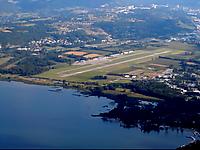
 flying in France
flying in France
General
France has a large number of airports and airfields. Most of them (more
than 400) are open to general aviation, and most of them are state owned.
If you fly a ULM, your choice is even greater, since you may land and
takeoff almost everywhere provided you have the land's owner agreement and
you endanger no one. A large number of ULM platforms are specific and not
usable for class A aircraft. On the other hand, many GA airports do not
accept ULMs. Similar restrictions apply for Gliders, Helicopters...
Check your airports guide.

If you fly a class A
aircraft, you cannot land and takeoff outside an official and
authorized airfield. (Obviously, this is not true any more in case of an
emergency.) If the airfield is privately owned, you must have the owner
agreement before you use it, and if it is restricted, you may have to
request an authorization by the local DAC (Direction de l'aviation civile,
the French CAA or FAA), before you may use it. The phone number to call in this
case is shown on the airfield chart and whether PPR is required.
Some airfields
theoretically open to general aviation, light
aircraft are not actually welcome. If one is given a clearance to land
on these airfields, taxes are so high that you will regret visiting there
at all. This is true for example in Nice (LFMN) airport. Light aircraft
should consider landing rather at the nearby Cannes (LFMD) airport, run by
the same operator. Same situation applies in Lyon, where we're supposed to use Lyon-Bron
instead of Lyon St Exupéry. Orly and Roissy are out of
reach even for IFR flights unless you sent a PPR several days before. If
you really want to land near Paris, use le Bourget, if you fly IFR.
Otherwise, the closest airport for VFR flights is Toussus le Noble, SW of
Paris. Unfortunately, it is almost impossible to get from Toussus to the
centre of Paris using public transport.
Generally, unlike what happens in other countries, especially in the USA,
light aircraft and commercial traffic are largely kept apart. More and more "large"
airports are becoming difficult to use when you fly a small plane, and you
are not welcome there. Fortunately, we still have many little airfields.
But this might be a problem for a non French speaking pilot, unable to use
most of these little airfields.
Unless stated otherwise on the airfield chart, pattern elevation for
planes is usually 1000 ft AGL. When you're heading toward an uncontrolled
airfield, you are supposed to fly overhead the airfield, 500 ft ABOVE the
pattern. Then, after checking the windsock you may enter the downwind leg.
This is a very important problem if you don't speak French, because it
will prevent you from using many smaller airfields.
English is spoken in many
controlled airfields and these are well listed in your airfield guide.
However, France has many less important airfields where French only
is spoken. Most small airfields do not have ATC and pilots auto-report on the radio
IN FRENCH their positions and intentions for others who might be
approaching or who are already in the circuit.
Some airports have their own frequencies (ATIS, TWR, AFIS, APP), others
have no frequency. If radio is however to be used to land or take off on
these platforms, you must then use 123.5, a kind of unicom frequency.
Don't forget to begin your message with the name of the airport you're
going to use, because other nearby airports may use the same frequency ,
with pilots searching where this damned pilot announcing "turning base"
may be. Of course, French only is allowed on this frequency, as in many
airfields. This information is always given in your airfield guide.
Do not even try to go to such an airfield unless your
French is quite
good. This could be lethal. To know more about radioing in French, see the
R/T page.
Eventually, airports you can use according to regulations if you don't
speak French are those where r/t in English is possible (controlled
airports), and those where radio is not obligatory. Always check the
charts, but you will find a large number of fields available to you.
Fuel is not available everywhere. 100LL is much more common than Jet A1
on small airfields. Beware of the opening hours and days. This kind of
information is written on the APT chart. Usually, you won't have to order
or book your fuel prior to your visit, provided that you come when the
station is open. There are very few (too few) automatic stations open H24.
But if you're careful enough, filling your tanks should not be a problem
in France. Beware, though : in many places where fuel is sold by aero-clubs,
you won't be able to use your credit card. Checks in foreign currencies
won't do either. The only way to pay then might be to pay cash. Prepare
yourself to that.
